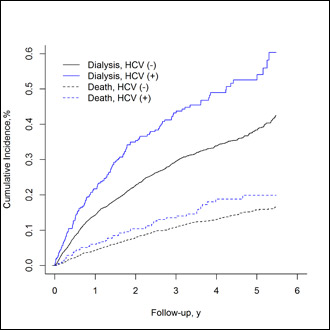Alternative model links HCV to high ESRD rates
A death-adjusted competing risk model has shown that infection with hepatitis C virus was associated with an increased risk for developing end-stage renal disease among patients with chronic kidney disease, according to study results published in PLOS ONE.
The risk for end-stage renal disease (ESRD) in patients with kidney disease may be overestimated according to traditional survival analyses, researchers noted. Therefore, a competing risk model that adjusts for death may more accurately assess the risk for ESRD.
Researchers from Taiwan applied competing risk analysis to a cohort of 4,185 patients (mean age, 62 years; 41% female) at two affiliated hospitals at Kaohsiung Medical University between November 2002 and May 2009. They analyzed the association between HCV and HBV infection and the risk of entering ESRD using both traditional and competing risk analyses. HCV and HBV infections were confirmed through serology tests.
Results indicated that the prevalence of HCV infection was 7.6% and increased as chronic kidney disease advanced (P<.001). The prevalence of HBV was 7.4% but was nearly constant throughout the various stages of chronic kidney disease. During 9,101 person-years of follow-up, there were 446 deaths and 1,205 patients who entered ESRD.

Figure 1. The cumulative incidence of end-stage renal disease adjusted competing for death plot showed that HCV infection had a higher cumulative rate of end-stage renal disease than cases without HCV infection (modified log-rank, P<.001).
Source: Shang-Jyh Hwang/PLOS ONE
The overall cumulative incidence of ESRD was 49% using the Kaplan-Meier method. However, the incidence decreased to 39.6% using the competing risk method, demonstrating the differences in rates between the two.
“A death-adjusted competing risk model is better than traditional survival analyses, which may overestimate the risks,” study researcher Shang-Jyh Hwang, MD, director of the departments of internal medicine and clinical education and training at Kaohsiung Medical University Hospital, Taiwan, told Infectious Disease News.
After adjusting for death as a competing risk, the estimated 5-year cumulative incidence rate of ESRD was significantly higher among patients with HCV infection vs. those without HCV infection (52.6% vs. 38.4%; P<.001).
In multivariable analysis, patients with HCV infection (HR=1.32; 95% CI, 1.07-1.62) but not HBV infection (HR=1.1; 95% CI, 0.89-1.35) were at a higher risk for ESRD compared with those without infection.
By applying the death-adjusted competing risk model, the researchers demonstrated that HCV infection still led to a high rate of ESRD and was an independent risk factor for ESRD.
“This substantial clinical significance suggests that future investigations on HCV treatment and renal outcome are needed to elucidate better care for [the chronic kidney disease] population,” the researchers concluded. — John Schoen
Shang-Jyh Hwang, MD, can be reached at: Division of nephrology, department of internal medicine, 100 Tzyou 1st Rd., San-Ming District, Kaohsiung City, 807, Taiwan; email: sjhwang@kmu.edu.tw.
Disclosure: One of the researchers is a PLOS ONE Editorial Board member.
